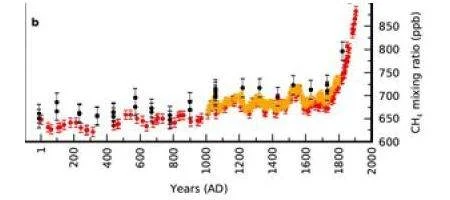Human beings have been pumping methane into the atmosphere since Roman times, in enough quantity for it to show up in the Greenland ice sheet.

Much of the methane in the atmosphere comes from natural sources such as the bacteria in wetlands, But the team’s used special analytical methods to determine how much is man-made, through activities such as growing rice and burnig wood for fuel.
“The different sources of methane have different isotopic compositions. The methane produced by the burning of biomass, like wood, contains more of the heavier isotope (carbon-13) relative to the lighter isotope (carbon-12), than methane which is produced in wetlands,” says Professor Thomas Blunier of the Niels Bohr Institute at the University of Copenhagen.
And measuring the isotopic composition of the methane in ice cores from the Greenland ice cap shows that human beings have been influencing the amout of methane in the atmosphere for a long time.
“We can see that already 2,100 years ago during Roman times, some cultures were spreading out and burning large amounts of wood for fuel in furnaces to work with metals that required intense heat to process. But the level was still low,” says Blunier.
“The next significant increase was during the Middle Ages around 1,000 years ago. It was a warm period and it was dry so there were presumably many forest fires that emitted methane while the wetlands dwindled and reduced methane emissions from that source.”
The analyses show large increases from around the year 1800. About half originates from the production of food, especially rice fields and cattle. A lot more comes from rotting organic materials and burning coal for energy.
“The extent to which our ancestors were able to influence the emissions of methane with their activities is surprising,” says Blunier.
“The general trend from 100 BCE to the year 1600 shows a correlation between the increase in the appropriation of land for cultivation and the emission of the biogenic methane. Today, half of the methane emissions stem from human activities.”






